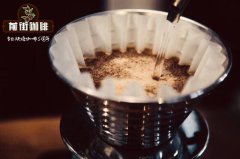How does the aroma of coffee come out? the strong aroma of coffee beans is fried just right.

Professional coffee knowledge exchange more coffee bean information please follow the coffee workshop (Wechat official account cafe_style)
Qianjie-introduction to the source of coffee aroma
1 caramel reaction
The sugar in coffee beans reacts with caramel at about 170-200 ℃, which is exactly the melting point of sucrose [185 ℃], the temperature at which coffee beans are roasted at the stage of explosion. The product of caramel reaction is divided into two parts:
The dehydration product of a sugar is caramel or sauce.
B pyrolysis products, mainly volatile aldehydes and ketones
In general, the caramel reaction produces fire-roasted aroma, caramel and color, as well as other aromatic substances such as maltol, Cyclotene, furan compounds, etc., which can also be found in red wine, fruit juices, cream and other foods. However, if caramel is too much in the baking process is not a good thing, but will cause carbonization, making the coffee dry and choking. If the caramel is not enough, it will make the aroma monotonous and lack of layers.
2 Mena reaction
The Mena reaction can be divided into three stages.
Initial stage: carbonylamine condensation Amadori molecular rearrangement
In the second metaphase: glycosamine, a product of Amadori molecular rearrangement, is dehydrated to HMF [hydroxymethylfurfural], fructosamine removes aminoglycoketones, and amino acids interact with dicarbonyl compounds.
Third, the last stage: Aldol condensation, the polymerization of melanin.
In addition to sugars, proteins account for about 11% of the weight of raw beans, and the amino acids contained in these proteins are exactly the raw materials needed for the Mena reaction. Mena reaction refers to a series of reactions between amino acids and reducing sugars [glucose, fructose, lactose, etc.] in food during heating. The Mena reaction produces a very variety of aromatic substances with pigments such as Pyridines,Pyrazines,Oxazoles,Thiazoles,Pyrroles. Mena reaction plays an important role in the flavor of food cooking, whether the sausage blackens and gives off fragrance when baking sausages, and the roast chicken is soft on the outside. Mena is responsible for the complete color, smell and flavor of these barbecue foods.
Coffee is blessed with a wide variety of complex chemicals, in addition to the above-mentioned compounds, there are other organic acids, inorganic acids, alkaloids and other ingredients. Not only sweet and beautiful ingredients, some slightly bitter compounds make coffee flavor have a wider level and change, together to create a unique rich taste of coffee.
Knowledge: shallow roasting is mainly sour and flavor, if the baking is not handled properly, there will be a sense of astringency and irritation, while the mellow thickness and flavor of coffee feel lower.
In short: Qianjie is a coffee research hall, happy to share the knowledge about coffee with you, we share unreservedly just to make more friends fall in love with coffee, and there will be three low-discount coffee activities every month. The reason is that Qianjie wants to make more friends drink the best coffee at the lowest price, which has been Qianjie's tenet for 6 years!
END
Important Notice :
前街咖啡 FrontStreet Coffee has moved to new addredd:
FrontStreet Coffee Address: 315,Donghua East Road,GuangZhou
Tel:020 38364473
- Prev

What is the fragrance of coffee beans? why the aroma of coffee beans comes from inexplicable chemical reactions.
Professional coffee knowledge exchange more coffee bean information please follow the coffee workshop (Wechat official account cafe_style) front street-coffee aroma source introduction aroma, flavor, aftertaste, acidity and alcohol thickness these five attributes are collided by different compounds. On the cup table, we use our senses to analyze the taste and aroma, which are also caused by chemical compounds. Let's smell dried incense first.
- Next

Is the charred aroma of coffee exclusive to deep roasting? how do you describe the aroma of coffee? you can drink it.
Professional coffee knowledge exchange more coffee bean information please follow the coffee workshop (Wechat official account cafe_style) front street-coffee aroma sources introduce coffee beans in different roasting stages will change. After the raw coffee beans absorb heat, the color changes from green to yellow, and the moisture content of beans begins to decrease. Heat energy converts the water inside the coffee bean into steam and produces dioxygen inside the coffee bean.
Related
- Beginners will see the "Coffee pull flower" guide!
- What is the difference between ice blog purified milk and ordinary milk coffee?
- Why is the Philippines the largest producer of crops in Liberia?
- For coffee extraction, should the fine powder be retained?
- How does extracted espresso fill pressed powder? How much strength does it take to press the powder?
- How to make jasmine cold extract coffee? Is the jasmine + latte good?
- Will this little toy really make the coffee taste better? How does Lily Drip affect coffee extraction?
- Will the action of slapping the filter cup also affect coffee extraction?
- What's the difference between powder-to-water ratio and powder-to-liquid ratio?
- What is the Ethiopian local species? What does it have to do with Heirloom native species?

